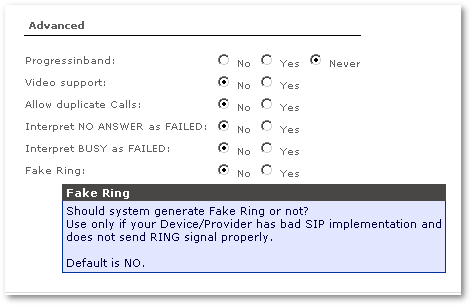Difference between revisions of "Fake Ring"
| Line 1: | Line 1: | ||
''This option is available starting from [[MOR_9_documentation | MOR9]]'' | ''This option is available starting from [[MOR_9_documentation | MOR9]]'' | ||
=== What is Fake Ring? === | |||
'''IMPORTANT:''' ring signal by default is generated by end-device, not the server in the middle! | |||
Lets say A (caller) calls to B (calee). We have such call flow: | |||
A -> MOR -> B | |||
Sequence of events: | |||
1. A pickups the phone and enters B number, presses DIAL to initiate call | |||
2. Call reaches MOR and MOR delivers call to B | |||
3. MOR tells A that it is trying to reach B | |||
4. A phone generates '''ringing signal''' to tell the Caller that B is notified about the call and is waiting when he pickups | |||
5. Till B does not pickup, B (Calee) hears signal which means that somebody is calling him | |||
6. When B pickups - call starts between A and B | |||
In some situations A does not generate ringing signal so it is possible to tell MOR to send Fake Ring signal to A | |||
Then in (4.) MOR sends Fake Ring signal to A so the Caller could hear the Ringing signal. | |||
'''IMPORTANT!''' Try to avoid using Fake Ring. This is considered very bad practice, because it hides these cases when device is unreachable or BUSY. <br> | |||
Caller still hear ringing signal in such situations and can be confused. | |||
<br><br> | |||
=== Enabling Fake Ring === | |||
This function lets set Fake Ring signal on Devices/Providers which do not send correct RING signal. This should not be used very often, because it is unprofessional. | This function lets set Fake Ring signal on Devices/Providers which do not send correct RING signal. This should not be used very often, because it is unprofessional. | ||
Revision as of 08:17, 10 December 2009
This option is available starting from MOR9
What is Fake Ring?
IMPORTANT: ring signal by default is generated by end-device, not the server in the middle!
Lets say A (caller) calls to B (calee). We have such call flow:
A -> MOR -> B
Sequence of events:
1. A pickups the phone and enters B number, presses DIAL to initiate call 2. Call reaches MOR and MOR delivers call to B 3. MOR tells A that it is trying to reach B 4. A phone generates ringing signal to tell the Caller that B is notified about the call and is waiting when he pickups 5. Till B does not pickup, B (Calee) hears signal which means that somebody is calling him 6. When B pickups - call starts between A and B
In some situations A does not generate ringing signal so it is possible to tell MOR to send Fake Ring signal to A
Then in (4.) MOR sends Fake Ring signal to A so the Caller could hear the Ringing signal.
IMPORTANT! Try to avoid using Fake Ring. This is considered very bad practice, because it hides these cases when device is unreachable or BUSY.
Caller still hear ringing signal in such situations and can be confused.
Enabling Fake Ring
This function lets set Fake Ring signal on Devices/Providers which do not send correct RING signal. This should not be used very often, because it is unprofessional.
By default it is NO (disabled).
Generate a ringing tone for the calling party, passing no audio from the called channel(s) until one answers. Without this option, Asterisk will generate ring tones automatically where it is appropriate to do so; however, "r" will force Asterisk to generate ring tones, even if it is not appropriate. For example, if you used this option to force ringing but the line was busy the user would hear "RING RIBEEP BEEP BEEP", which is potentially confusing and/or unprofessional. However, the option is necessary in a couple of places. For example, when you're dialing multiple channels, call progress information is not consistently passed back. (http://www.voip-info.org/wiki/view/Asterisk+cmd+Dial)
It can be set in Device and Provider details:

